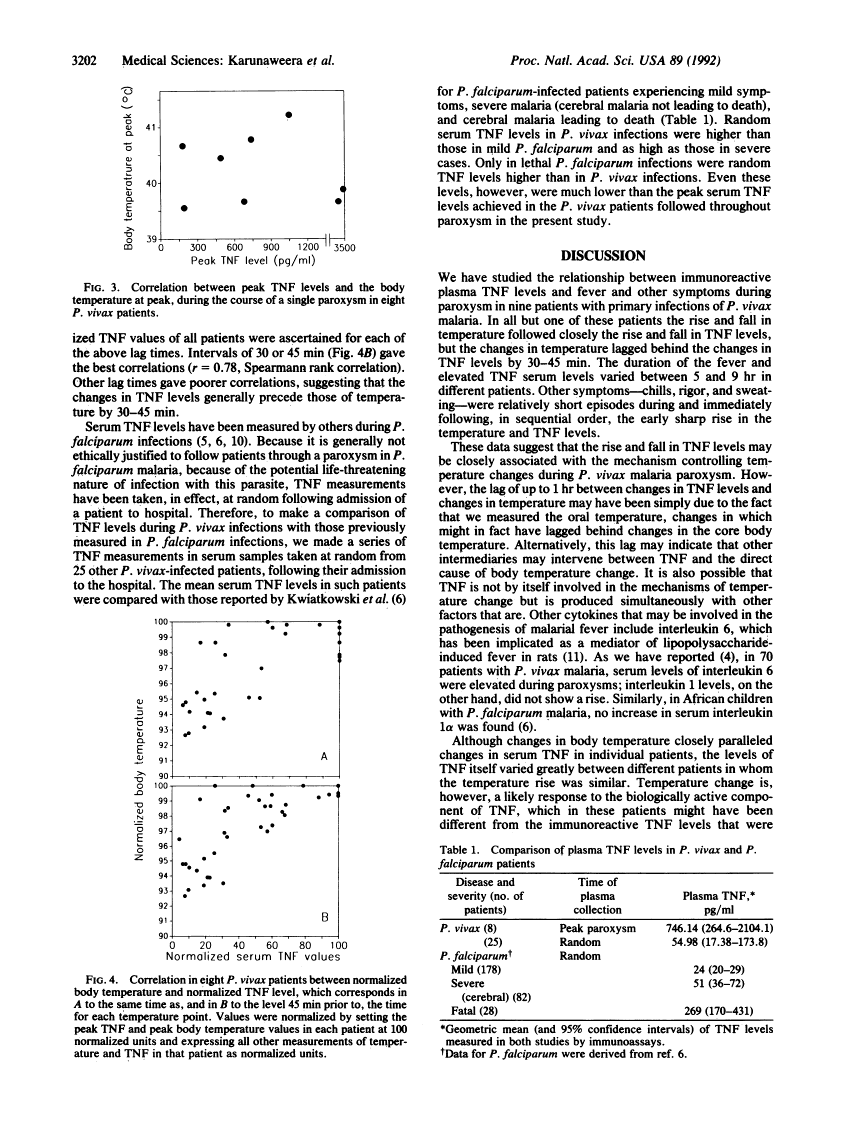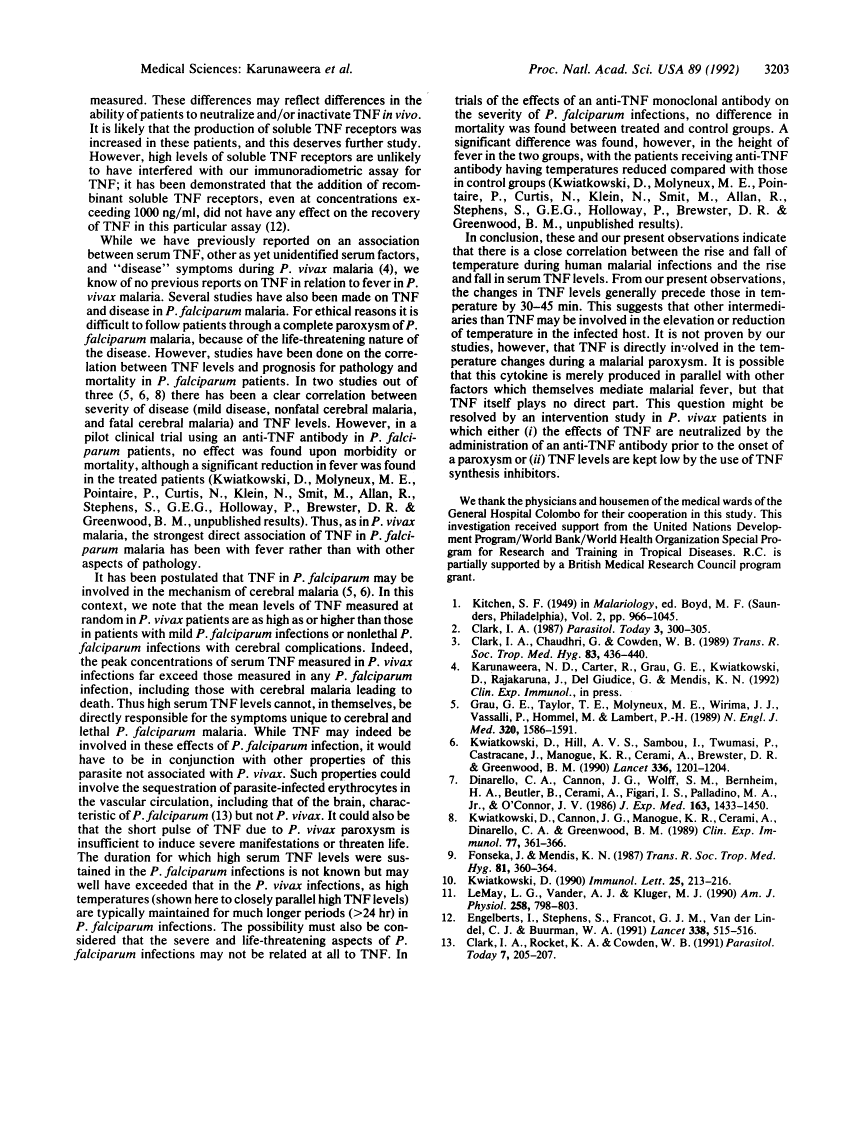Abstract
Free full text

Dynamics of fever and serum levels of tumor necrosis factor are closely associated during clinical paroxysms in Plasmodium vivax malaria.
Abstract
Paroxysms are sharp episodes of high fever accompanied by chills and rigors that occur periodically, once in every 48 hr in Plasmodium vivax infections. We have measured the changing levels of serum tumor necrosis factor (TNF) during paroxysms in non-immune patients infected with P. vivax malaria. The changes in TNF levels closely paralleled the rise and fall in temperature during the paroxysms but tended to precede them by 30-60 min. These observations suggest that the rise and fall in temperature during P. vivax paroxysm may be directly related to the periodic changes in TNF levels induced during these infections. The peak TNF levels reached during P. vivax infections were much higher than even those which have been recorded during severe and fatal P. falciparum infections in which TNF has been postulated to contribute to the severe manifestations of this disease.
Full text
Full text is available as a scanned copy of the original print version. Get a printable copy (PDF file) of the complete article (861K), or click on a page image below to browse page by page. Links to PubMed are also available for Selected References.
Images in this article
Click on the image to see a larger version.
Selected References
These references are in PubMed. This may not be the complete list of references from this article.
- Clark IA. Cell-mediated immunity in protection and pathology of malaria. Parasitol Today. 1987 Oct;3(10):300–305. [Abstract] [Google Scholar]
- Clark IA, Chaudhri G, Cowden WB. Roles of tumour necrosis factor in the illness and pathology of malaria. Trans R Soc Trop Med Hyg. 1989 Jul-Aug;83(4):436–440. [Abstract] [Google Scholar]
- Grau GE, Taylor TE, Molyneux ME, Wirima JJ, Vassalli P, Hommel M, Lambert PH. Tumor necrosis factor and disease severity in children with falciparum malaria. N Engl J Med. 1989 Jun 15;320(24):1586–1591. [Abstract] [Google Scholar]
- Kwiatkowski D, Hill AV, Sambou I, Twumasi P, Castracane J, Manogue KR, Cerami A, Brewster DR, Greenwood BM. TNF concentration in fatal cerebral, non-fatal cerebral, and uncomplicated Plasmodium falciparum malaria. Lancet. 1990 Nov 17;336(8725):1201–1204. [Abstract] [Google Scholar]
- Dinarello CA, Cannon JG, Wolff SM, Bernheim HA, Beutler B, Cerami A, Figari IS, Palladino MA, Jr, O'Connor JV. Tumor necrosis factor (cachectin) is an endogenous pyrogen and induces production of interleukin 1. J Exp Med. 1986 Jun 1;163(6):1433–1450. [Europe PMC free article] [Abstract] [Google Scholar]
- Kwiatkowski D, Cannon JG, Manogue KR, Cerami A, Dinarello CA, Greenwood BM. Tumour necrosis factor production in Falciparum malaria and its association with schizont rupture. Clin Exp Immunol. 1989 Sep;77(3):361–366. [Abstract] [Google Scholar]
- Fonseka J, Mendis KN. A metropolitan hospital in a non-endemic area provides a sampling pool for epidemiological studies on vivax malaria in Sri Lanka. Trans R Soc Trop Med Hyg. 1987;81(3):360–364. [Abstract] [Google Scholar]
- Kwiatkowski D. Tumour necrosis factor, fever and fatality in falciparum malaria. Immunol Lett. 1990 Aug;25(1-3):213–216. [Abstract] [Google Scholar]
- Engelberts I, Stephens S, Francot GJ, van der Linden CJ, Buurman WA. Evidence for different effects of soluble TNF-receptors on various TNF measurements in human biological fluids. Lancet. 1991 Aug 24;338(8765):515–516. [Abstract] [Google Scholar]
- Clark IA, Rockett KA, Cowden WB. Proposed link between cytokines, nitric oxide and human cerebral malaria. Parasitol Today. 1991 Aug;7(8):205–207. [Abstract] [Google Scholar]
Associated Data
Articles from Proceedings of the National Academy of Sciences of the United States of America are provided here courtesy of National Academy of Sciences
Full text links
Read article at publisher's site: https://doi.org/10.1073/pnas.89.8.3200
Read article for free, from open access legal sources, via Unpaywall:
http://www.pnas.org/content/89/8/3200.full.pdf
Citations & impact
Impact metrics
Article citations
Circadian Control of the Response of Macrophages to Plasmodium Spp.-Infected Red Blood Cells.
Immunohorizons, 8(6):442-456, 01 Jun 2024
Cited by: 0 articles | PMID: 38916585 | PMCID: PMC11220744
Immune mechanisms targeting malaria transmission: opportunities for vaccine development.
Expert Rev Vaccines, 23(1):645-654, 01 Jan 2024
Cited by: 1 article | PMID: 38888098
Review
Tumor necrosis factor-α (TNF-α) -308G >a promoter polymorphism (rs1800629) promotes Asians in susceptibility to Plasmodium falciparum severe malaria: A meta-analysis.
PLoS Negl Trop Dis, 17(11):e0011735, 01 Nov 2023
Cited by: 0 articles | PMID: 37910577 | PMCID: PMC10655976
Profiles of host immune impairment in Plasmodium and SARS-CoV-2 infections.
Heliyon, 8(12):e11744, 18 Nov 2022
Cited by: 2 articles | PMID: 36415655 | PMCID: PMC9671871
Review Free full text in Europe PMC
Potential of nanoformulations in malaria treatment.
Front Pharmacol, 13:999300, 26 Oct 2022
Cited by: 8 articles | PMID: 36386185 | PMCID: PMC9645116
Review Free full text in Europe PMC
Go to all (134) article citations
Similar Articles
To arrive at the top five similar articles we use a word-weighted algorithm to compare words from the Title and Abstract of each citation.
The role of cytokines in Plasmodium vivax malaria.
Mem Inst Oswaldo Cruz, 87 Suppl 3:51-55, 01 Jan 1992
Cited by: 5 articles | PMID: 1343726
Review
Tumour necrosis factor-dependent parasite-killing effects during paroxysms in non-immune Plasmodium vivax malaria patients.
Clin Exp Immunol, 88(3):499-505, 01 Jun 1992
Cited by: 49 articles | PMID: 1351432
A malaria parasite toxin associated with Plasmodium vivax paroxysms.
Clin Exp Immunol, 104(2):221-227, 01 May 1996
Cited by: 10 articles | PMID: 8625512
Changing scenario of malaria: a study at Calcutta.
Indian J Malariol, 35(2):111-116, 01 Jun 1998
Cited by: 6 articles | PMID: 10448229










